This Townhouse Could Be Yours
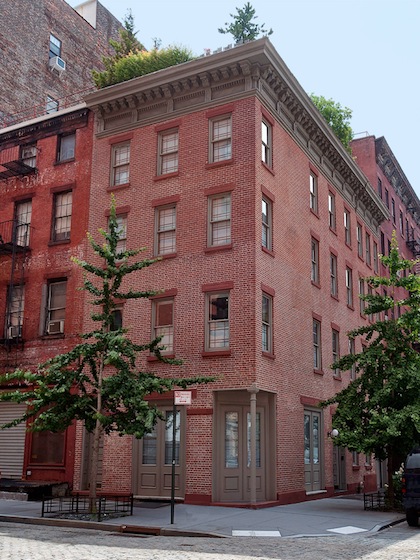 One tries not to get into a tizzy just because another high-priced piece of real estate hit the market, but when it’s a $24.5 million corner townhouse in northwest Tribeca, attention must be paid. (Wait, is that not what Linda Loman had in mind?) As the reader who spotted the StreetEasy listing for 452 Greenwich emailed to me: “This townhouse always seems to enchant people” walking in his neck of the woods.
One tries not to get into a tizzy just because another high-priced piece of real estate hit the market, but when it’s a $24.5 million corner townhouse in northwest Tribeca, attention must be paid. (Wait, is that not what Linda Loman had in mind?) As the reader who spotted the StreetEasy listing for 452 Greenwich emailed to me: “This townhouse always seems to enchant people” walking in his neck of the woods.
The Sotheby’s listing: “In all respects, this townhouse reflects a true rarity for Tribeca. The corner 4-story masonry building was originally constructed circa 1910 and has recently been completely renovated into a spectacular, mint condition single-family home with finished basement in the heart of the neighborhood.” Um, Greenwich and Desbrosses is more like the pineal gland of the neighborhood. “Windows along the east and north exposures flood the house with sunlight through 38 new windows. Not only does the house have a generous central stair hall, but it also has its own elevator and the ultimate Manhattan luxury: a large, private garage. The 2nd Floor incorporates the corner living room with wood burning fireplace, the dining room and an enormous open chef’s kitchen. Upstairs, the house has 5 large bedrooms, including the large master suite with its own wood burning fireplace. Downstairs is a large media room/guest room, home office, gym, wine storage for 3,000 bottles”—you’d have to hire a wine curator—”and on the roof a fully decked and planted multi-level deck, perfect for entertaining or quiet family gatherings.” That’s 11 rooms total, with six bedrooms, four full bath, and three half baths. The annual taxes are listed at $17,306.
Click on the photos to enlarge. Do you think the rugs were removed to make the rooms look bigger in the photos? Because those floors are begging for something.
UPDATE: Curbed looked at the sales history of the building: “This four-story Tribeca townhouse was purchased by a developer in 1998 for $499,000 and flipped to a real estate investment group for $1,500,000 the following year. Then, in 2003, an insurance executive and his wife bought the place for $5,650,000 and began a gut-renovation, introducing such necessities as a 3,000-bottle wine cellar, a one-car garage, a media room, a wood-burning fireplace, etc, etc. Target was so taken with the house that they used at as a set for commercials. And now, after lying in wait for nine years, the house has returned to market with an ask of $24,500,000.”







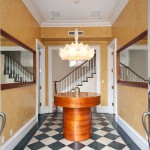
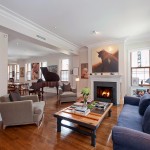
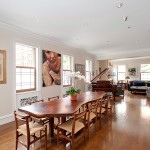
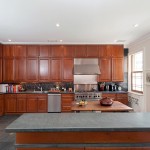
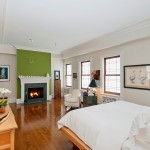
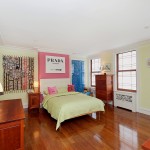
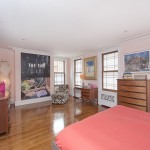
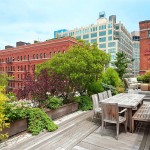
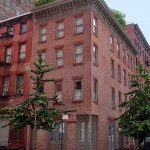






Don’t get me wrong-I’d give my first born for a kitchen that size, but the finishings?! Woof
Thanks for this. I often pause when walking by this place wondering what it’s like inside. I wonder no more. Possibly worth the price if the art is included ;)
This “townhouse” was mine for 22 years from 1978, or at least the entire middle floor. At that time there was a dirt cheap Latin restaurant on the ground floor (now office space and parking) catering to the factory workers in the area. This building was not built in 1910 but far earlier, and it wasn’t built as a “townhouse” but as commercial space. Just wanting to remind all the 1%’ers of the industrial roots of the neighborhood they have now so successfully taken over. Tribeca has a fabulous industrial history…Many of the people who moved to Tribeca in the 1960’s +’70’s were evicted (myself included) as the demographic changed. Let’s not whitewash the neighborhood by forgetting the gritty history of the place. It’s not the Upper East Side. Or maybe it is now but it wasn’t always. Just saying!
http://www.flickr.com/photos/emilio_guerra/5377521799/
Collister Street, was initially an alley which served stables at the rear of town houses facing the park. The narrow through-the-block lots which extend from Laight Street to Vestry Street, are also reminders of this first period of urbanization.
…The Hudson River shoreline developed around this same time, as landfill extended the perimeter of lower Manhattan to West Street. The blocks between Greenwich and West Streets developed as a mixed-use waterfront area, with tradesmen living near commercial and industrial operations. Many early nineteenth-century dwellings, such as those remaining at 450 and 452 Greenwich Street, were enlarged around 1850 with additional stories and converted for commercial use.
Cheryl, as one of the last few artists-in-residence loft dwellers from those early years to still be living and working in what became poshe Triburbia, I am very glad to see your post. These developers and 1%-ers who destroyed the incredible sense of neighborhood we had here in the ’60s and ’70s have no idea at all what they replaced. These were all industrial spaces, with the light industries of warehousing and trucking, machine shops and painting and sculpture all intermixed in these buildings, and the fresh foods coming in at the loading docks every morning, and the trucks and skids and forklifts all over the streets – these are unremembered and not even known about by most who live here at this point. Thanks for posting.
I’m so sorry that you lost that place. It was heartbreaking to see so many wonderful neighbors and dedicated artists lose their lofts so that developers could reap these kinds of profits.
Thanks Laurie, for your kind words. I am glad that you were able to stay. Clearly, the industrial base of Tribeca was slipping away by the ’60’s + 70’s–that’s why artists/etc were able to take over the loft spaces subsequently taken over by developers+ and the very very rich.
The ideal would be not keeping out the folks who can afford the $25 million+ residences but a social policy that encouraged/promoted mixed income neighborhoods. That did not happen in Tribeca …doesn’t happen much in NYC which is becoming more + more economically segregated.
By the way, I am perfectly happy living in Brooklyn. Which is where many of those cast out of the little paradise that was (and in many ways still is) Tribeca fled… and found happiness, new energy and grit.
This “townhouse” was mine for 22 years from 1978, or at least the entire middle floor. At that time there was a dirt cheap Latin restaurant on the ground floor (now office space and parking) catering to the factory workers in the area. This building was not built in 1910 but far earlier, and it wasn’t built as a “townhouse” but as commercial space. Just wanting to remind all the 1%’ers of the industrial roots of the neighborhood they have now so successfully taken over. Tribeca has a fabulous industrial history…Many of the people who moved to Tribeca in the 1960’s +’70’s were evicted (myself included) as the demographic changed. Let’s not whitewash the neighborhood by forgetting the gritty history of the place. It’s not the Upper East Side. Or maybe it is now but it wasn’t always. Just saying!
http://www.flickr.com/photos/emilio_guerra/5377521799/
Collister Street, was initially an alley which served stables at the rear of town houses facing the park. The narrow through-the-block lots which extend from Laight Street to Vestry Street, are also reminders of this first period of urbanization.
…The Hudson River shoreline developed around this same time, as landfill extended the perimeter of lower Manhattan to West Street. The blocks between Greenwich and West Streets developed as a mixed-use waterfront area, with tradesmen living near commercial and industrial operations. Many early nineteenth-century dwellings, such as those remaining at 450 and 452 Greenwich Street, were enlarged around 1850 with additional stories and converted for commercial use.
Cheryl…..Laurie….get a room.